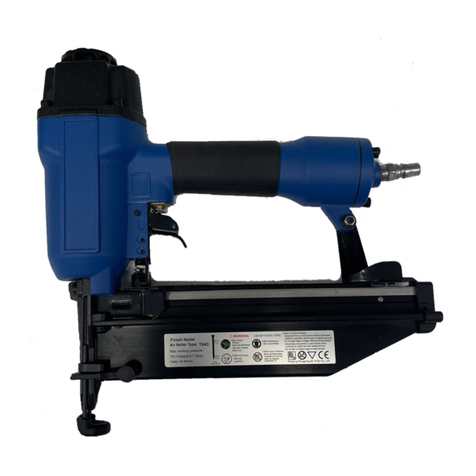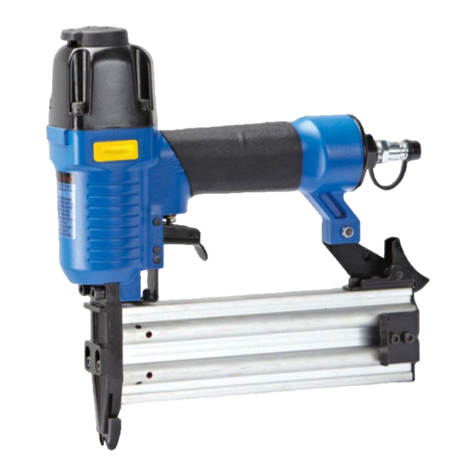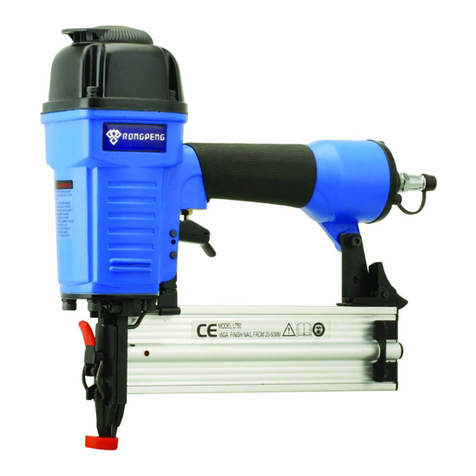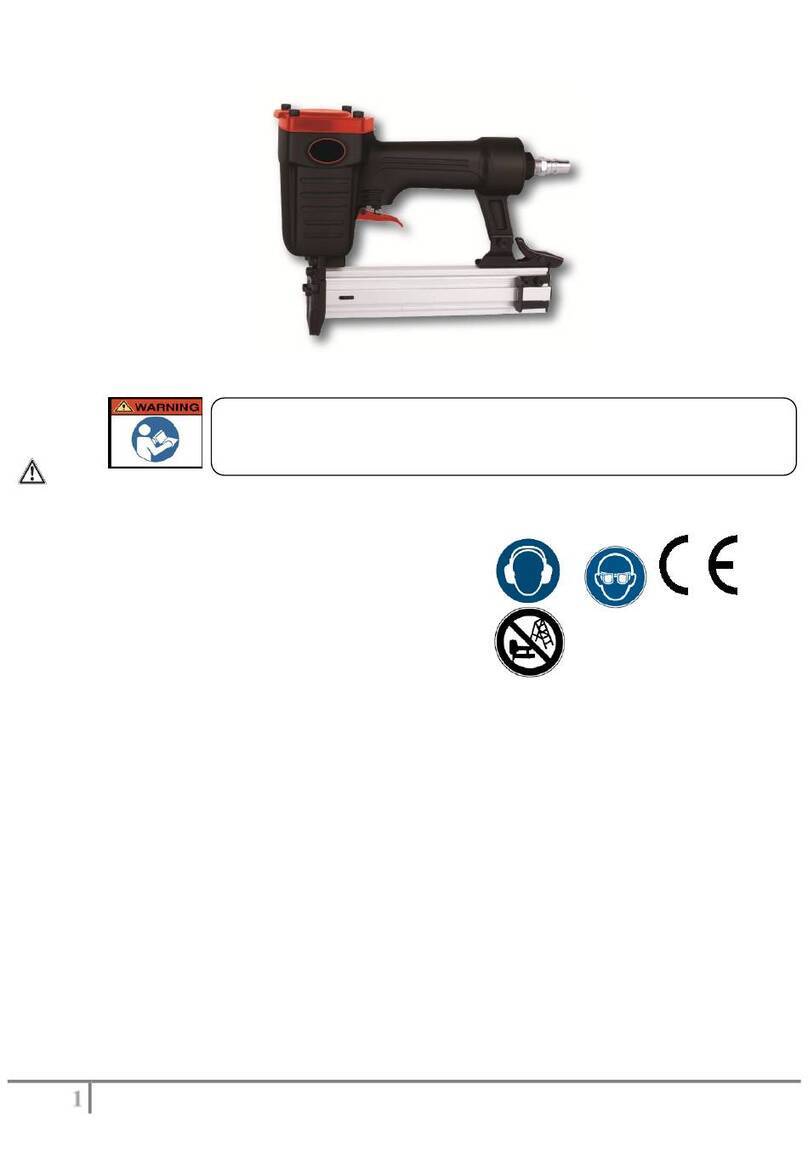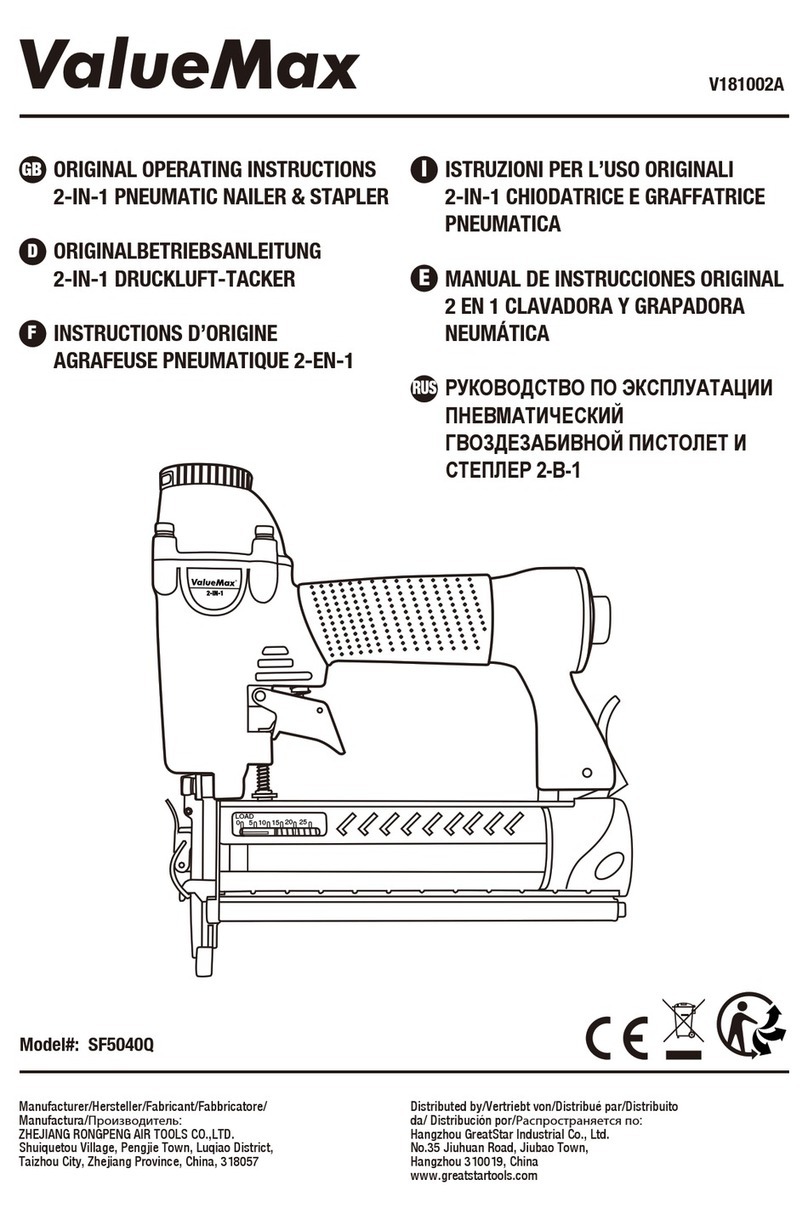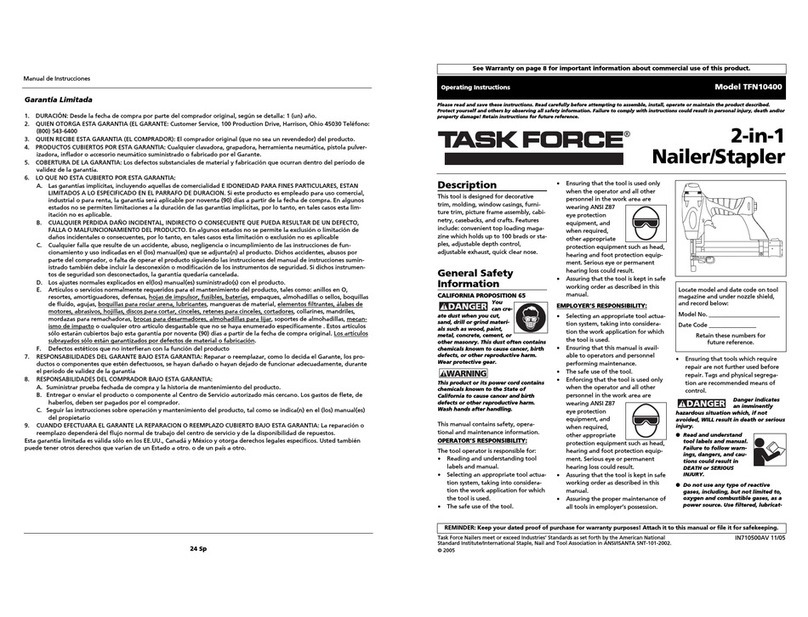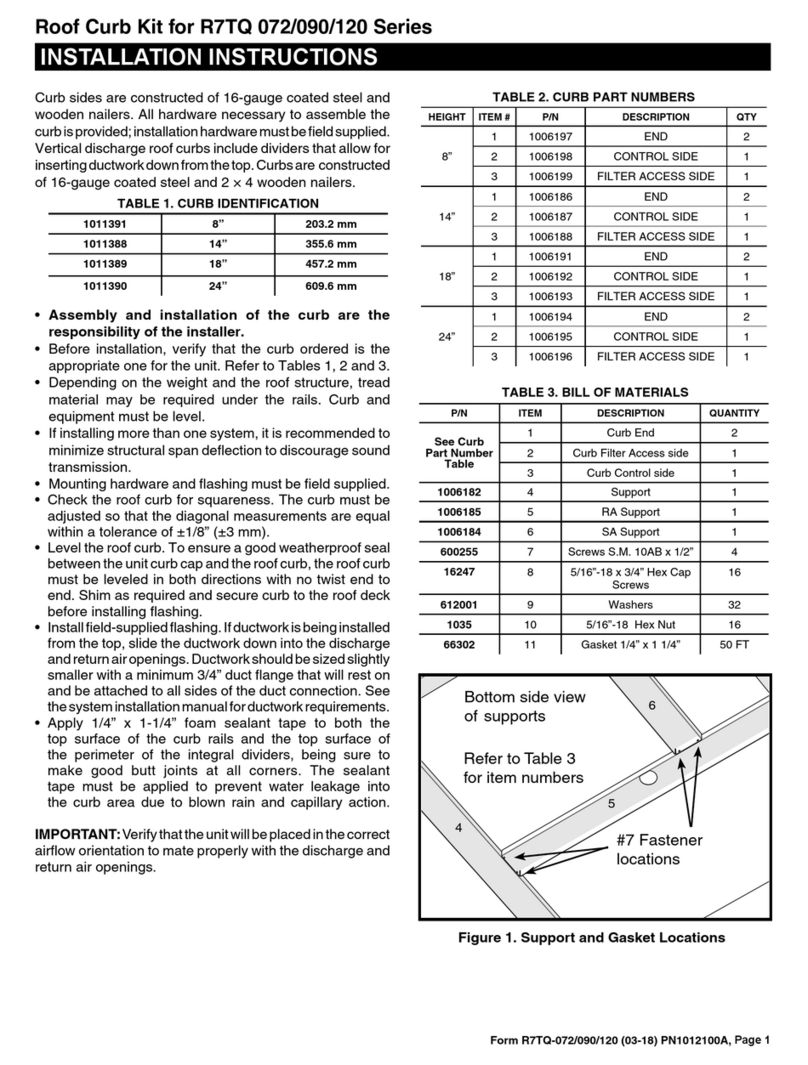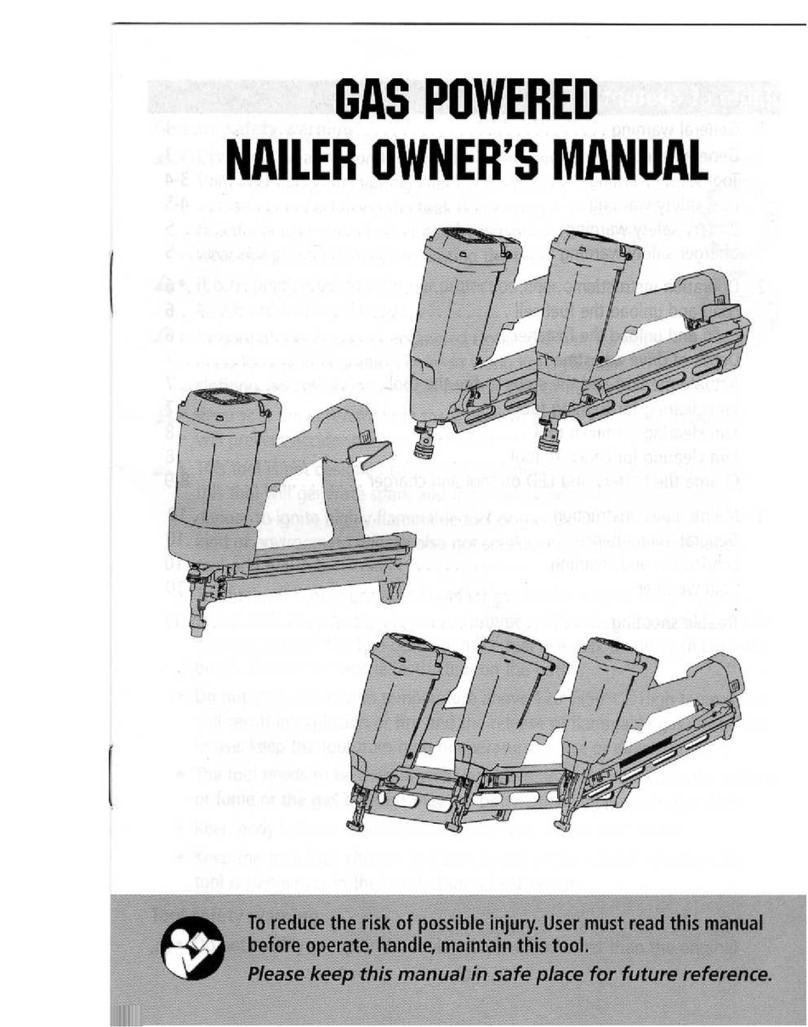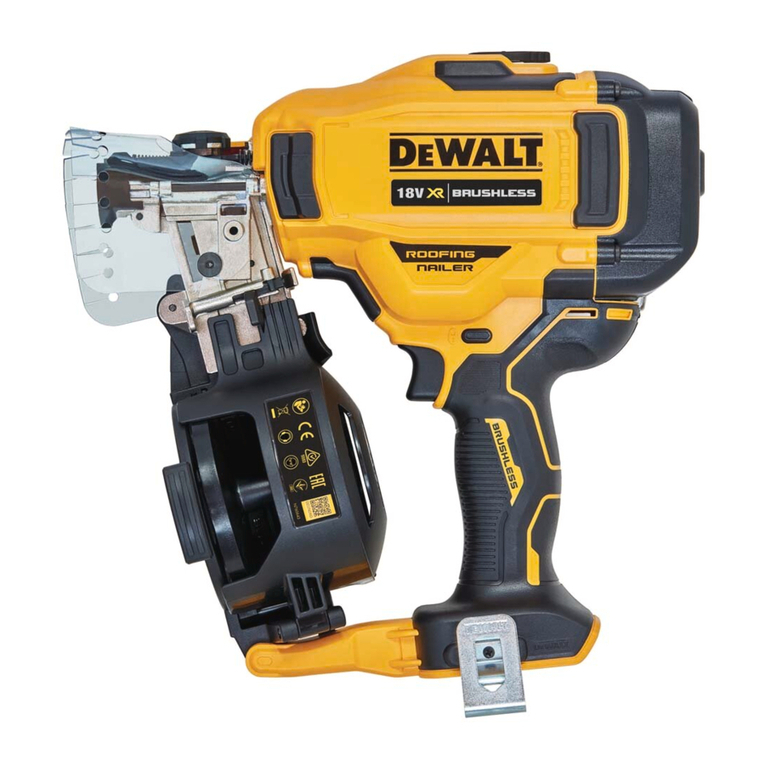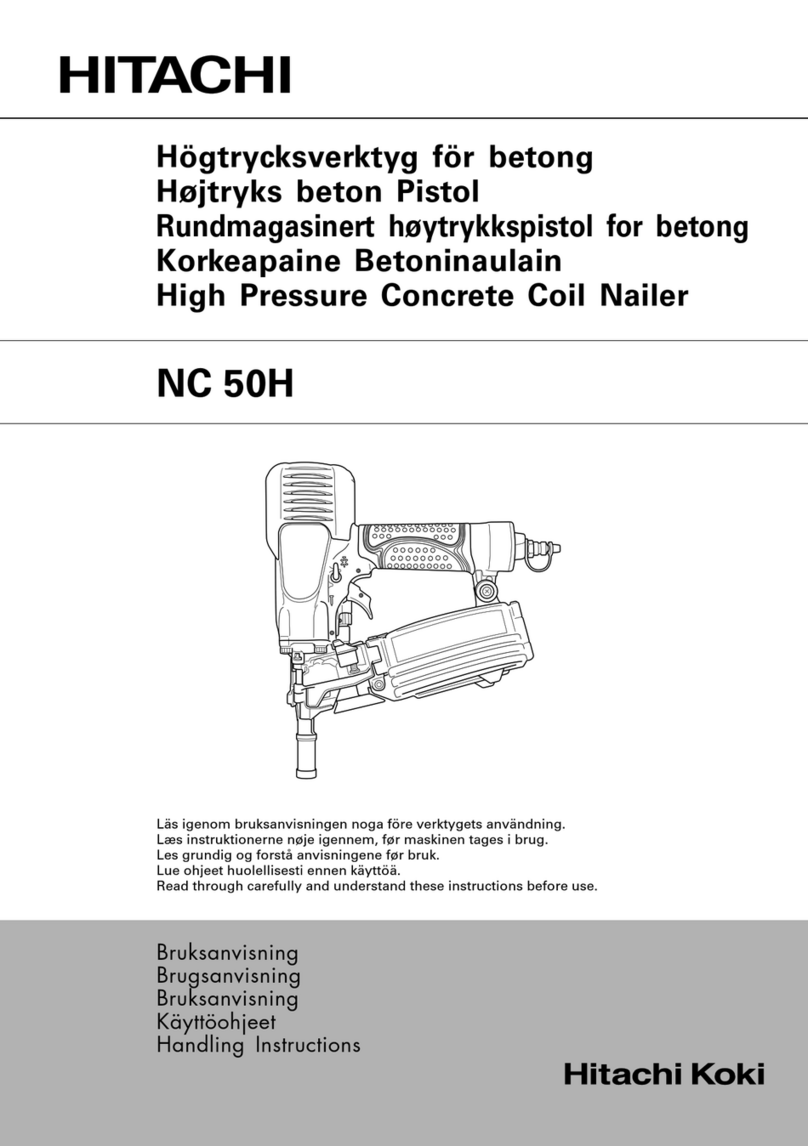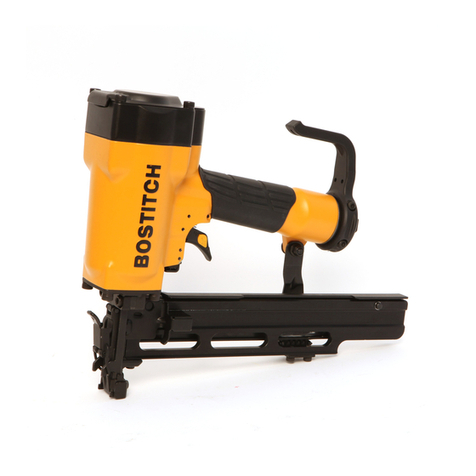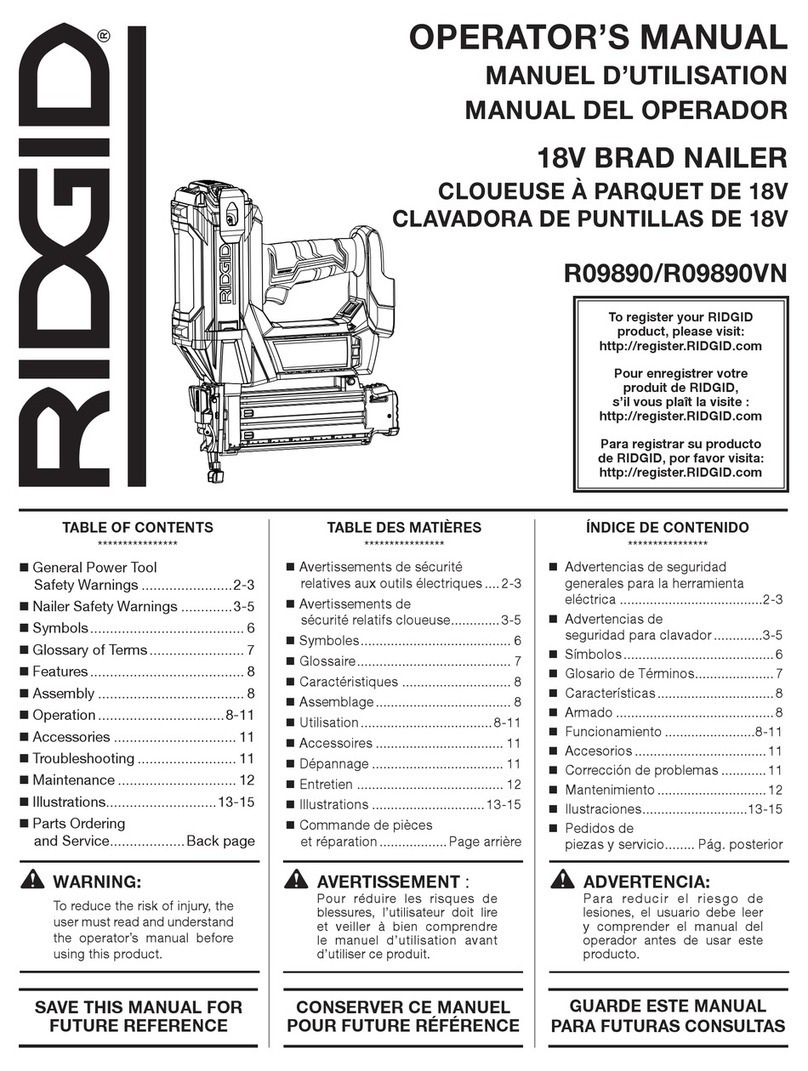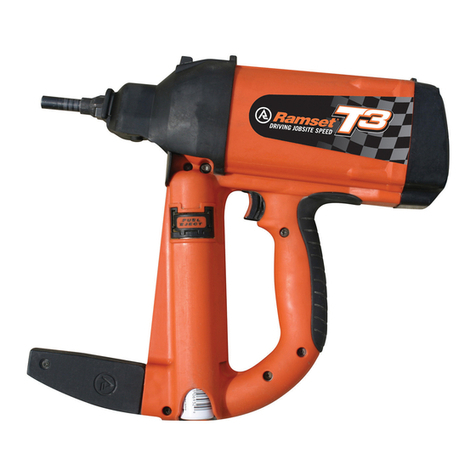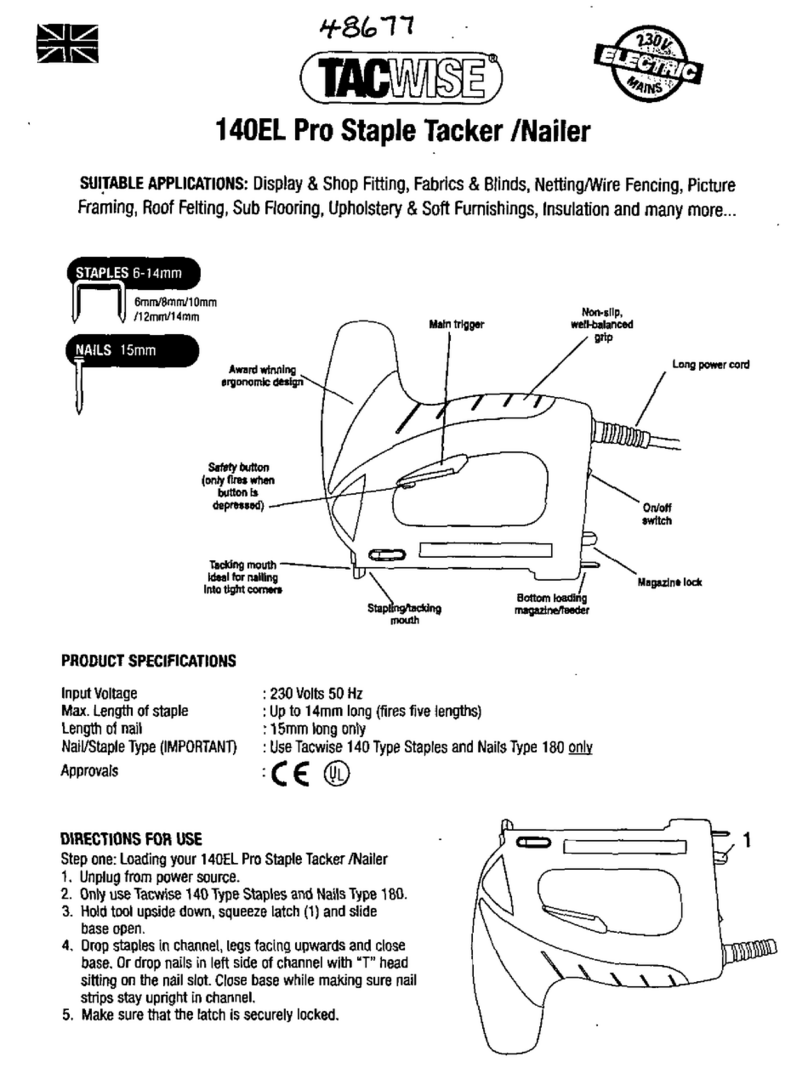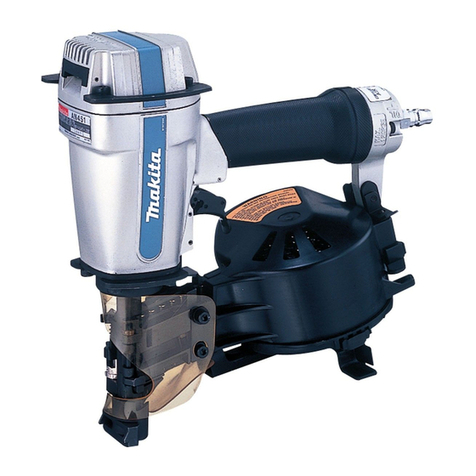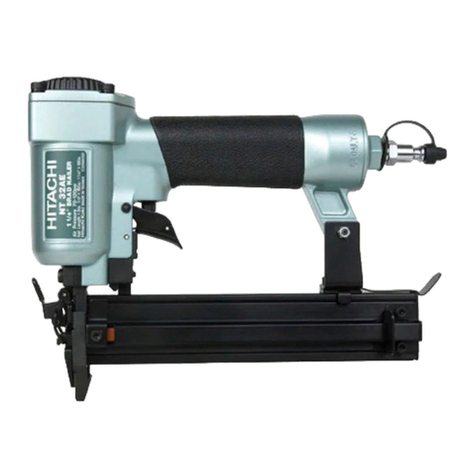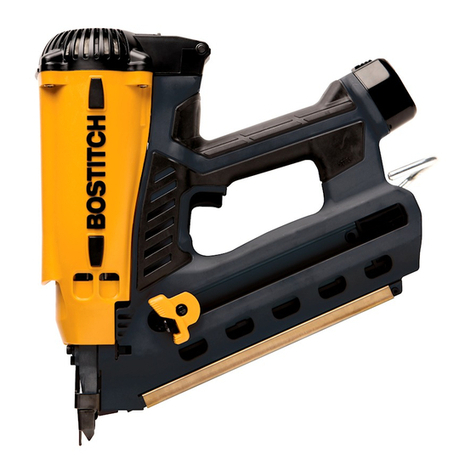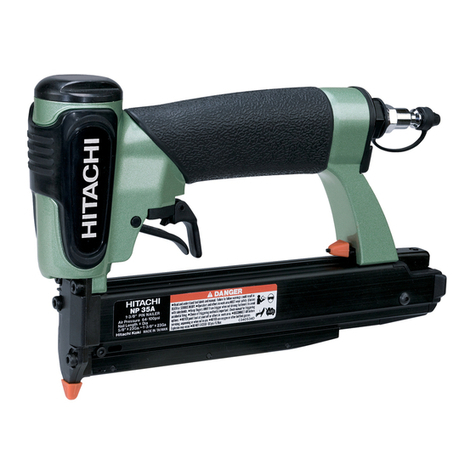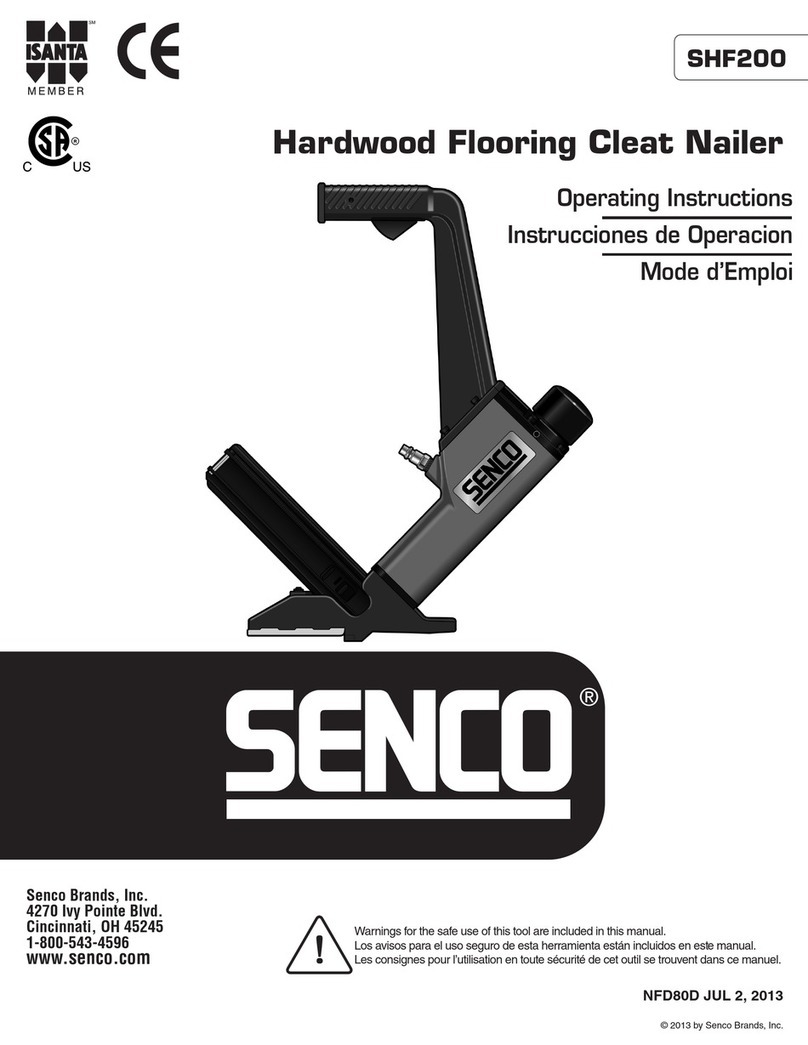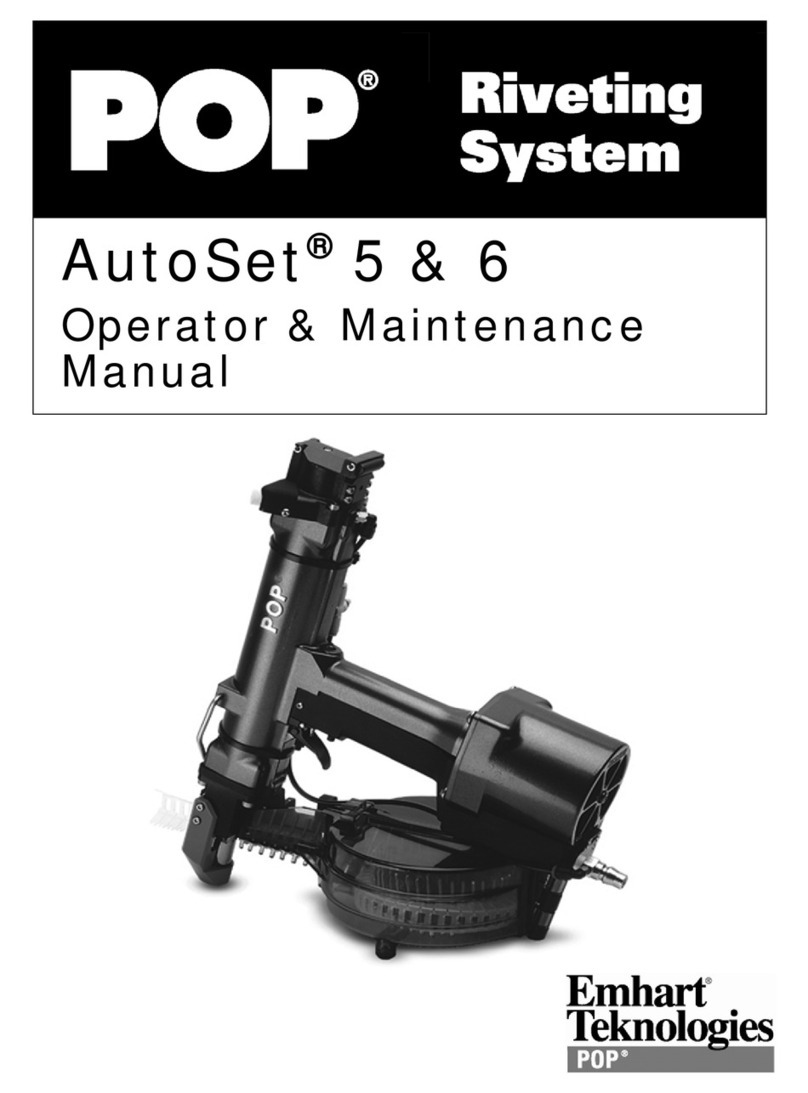Rongpeng F50M User manual

INSTRUCTION MANUAL
Air-powered Brad Nailer
F50M
Residual Risks
Even when the tool is used as prescribed it is not possible to eliminate all residual risk factors. The following hazards may
arise in connection with the tool’s construction and design:
1. Damage to lungs if an effective dust mask is not worn.
2. Damage to hearing if effective hearing protection is not worn.
3. Wear eye protection.
4. Health defects resulting from vibration emission if the power
tool is being used over longer period of time or not adequately managed and properly maintained.
TECHNICAL SPECIFICATIONS
MAGAZINE CAPACITY
100 nails
NAILS
18-gauge brad nails (5/8–2")
OPERATING PRESSURE
70–110 PSI (4.8–7.5 bar)
AIR INLET
1/4"
MAXIMUM PRESSURE
120 PSI (8.3 bar)
WEIGHT
3 lb 6 oz (1.55 kg)
CF: Cubic Feet (the volumetric flow rate of air corrected to standardized conditions of temperature and pressure).
SAFETY GUIDELINES
This manual contains information that relates to PROTECTING PERSONAL SAFETY and PREVENTING EQUIPMENT PROBLEMS.
It is very important to read this manual carefully and understand it thoroughly before using the product. The symbols listed
below are used to indicate this information.
DANGER! Potential hazard that will result in serious injury or loss of life.
WARNING! Potential hazard that could result in serious injury or loss of life.
CAUTION! Potential hazard that may result in injury or damage to equipment.
PERSONAL SAFETY
These precautions are intended for the personal safety of the user and others working with the user. Please take time to read
and understand them. Make sure you read and understand this manual before using this tool. Make sure other users read
and understand this manual before they use the tool.
IMPORTANT: Please read this manual carefully before using this product, and save it for reference.
This manual contains important safety and operating instructions. Read all instructions and follow them
with use of this product.
TABLE OF CONTENTS:
-TECHNICAL SPECIFICATIONS -SAFETY GUIDELINES
-KEY PARTS DIAGRAM -TECHNICAL INFORMATION
-TYPES OF NAILS -OPERATING INSTRUCTIONS
-MAINTENANCE -TROUBLESHOOTING
-EXPLODED VIEW - PARTS LIST
NOTE: If any parts are missing or damaged, or if you have any questions, please contact with rongpeng@rongpeng.com

NOTE: The word “Note” is used to inform readers of something they need to know about the tool.
•Do not use oxygen or any other combustible or bottled gas to power air-powered tools.
Failure to observe this warning
can cause explosion and serious personal injury or death. Use only compressed air to power
air-powered tools. Use a minimum of 25’ (7.6 m) of hose to connect the tool to the compressor. Failure to
comply will result in serious injury or loss of life.
• Risk of bursting. Make sure the regulator is adjusted so that the compressor outlet pressure is set lower than the
maximum operating pressure of the tool. Before starting the compressor, pull the ring on the safety valve to make
sure the valve moves freely. Drain water from tank after each use. Do not weld or repair the tank. Relieve all
pressure in the hose before removing or attaching accessories.
•Risk of electric shock. Do not expose a compressor to rain. Store it indoors. Disconnect the compressor from the
power source before servicing. The compressor must be grounded. Do not use grounding adaptors.
Risk of burns. The pump and the manifold generate high temperatures. In order to avoid burns or other injuries, do
not touch the pump, the manifold or the transfer tube while the compressor is running. Allow the parts to cool down
before handling or servicing. Keep children and pets away from the compressor at all times.
•Risk of personal injury. Do not direct compressed air from the air hose toward the user or other people or animals.
•Risk of inhalation. Never directly inhale the air produced by the compressor.
•Risk of bursting. Do not adjust the pressure switch or safety valve for any reason. They have been
preset at the factory for the compressor’s maximum pressure. Tampering with the pressure switch or the safety
valve may cause personal injury or property damage.
DANGER!
Potential hazard that will result in serious injury or loss of life.
•Keep children away from the work area. Do not allow children to handle power tools.
•Do not use this tool in the presence of flammable liquids or gases. Sparks that are created during use may ignite gases.
•Do not point the tool toward yourself or other people. Keep hands, feet and all other parts of the body clear from work area.
•Always ensure that the workpiece is firmly secured, leaving both hands free to control the tool.
•Always ensure that the tool has stopped after use, for safety purposes and to prevent possible damage to the tool or personal injury or death.
WARNING!
Potential hazard that could result in serious injury or loss of life.
•Do not allow unskilled or untrained individuals to operate the Air-powered Brad Nailer.
•Do not use the Air-powered Brad Nailer for any task other than that it is designed to perform.
•Keep hands and other parts of the body away from the firing head during use. Keep hands, feet, and all other parts of the
body at 8" (20 cm) away from the firing head. Nails can cause serious injury if they are deflected by the workpiece or by
objects in the workpiece or if they are driven away from the point of entry.
•Do not drive a nail on top of existing nails. The nail may ricochet, causing serious personal injury.
•Use only nails of the proper size and gauge, as specified in this manual (see section “Technical Specifications”). Failure to
comply could result in serious injury or loss of life.
•Protect the air hose and the power cord from damage and puncture. Inspect them for weak or worn spots before every
usage, and replace them if necessary.
•Always wear hearing protection when using the air compressor. Failure to do so may result in hearing loss.
•Do not carry the compressor while it is running.
•Do not operate the compressor if it is not in a stable position.
•Do not operate the compressor on a rooftop or in an elevated position that could allow the unit to fall or be tipped over.
•Always replace a damaged gauge before operating the unit.
•Carry the tool by the handle only. Do not carry the tool with a finger on the trigger. Do not carry the tool by the hose, the
magazine nor any other part.
•Keep proper footing at all times in order to ensure correct balance.

•Do not use a tool that is leaking air, with missing or damaged parts, or that requires repairs. Verify that all screws are securely tightened.
•For optimal safety and tool performance, inspect the tool before every usage in order to ensure free movement of
the trigger, safety mechanisms, and spring.
•Keep the work area clean. A cluttered or dirty workbench or floor are more prone to accidents. They should be kept clear and clean.
•This tool is not a toy. Use it with caution.
•Handling and storage of oil: Use the tool with adequate ventilation. Avoid contact of oil with eyes, skin, and clothing. Avoid
breathing spray or mist. Store in a tightly closed container in a cool, dry, well-ventilated area free from incompatible substances.
•Tripping hazard: The air hose may become a tripping hazard when it is placed in the work area.
•Do not store the tool in a freezing environment to prevent ice formation on the operating valves of the
tool, as doing so may cause tool failure.
•Disconnect the tool from the air supply before loading or changing nails in order to prevent a nail from
being fired during loading. Failure to comply may result in injury or damage to equipment.
•Use safety goggles and ear protection:
Wear safety glasses with side shields when operating the tool and verify that others in the work area are also
wearing safety glasses. Safety glasses must provide protection from flying particles from the front and the sides.
Air-powered tools are loud and the sound can cause hearing damage. Always wear ear protection to prevent
hearing damage and loss. Failure to comply may result in injury.
Do not use while under the influence of alcohol, drugs or medication.
KEY PARTS DIAGRAM
No.
Description
No.
Description
No.
Description
1
Air inlet plug
4
Safety tip
7
Trigger
2
Magazine latch
5
Quick release handle
8
Air deflector
3
Magazine
6
Depth adjustment dial
TECHNICAL INFORMATION
Compatible compressors
GUIDELINES FOR PROPER USE AND OPERATION
Be sure to use a proper air compressor with RONGPENGAir-powered tools. The compressor that is being used must be able to supply
appropriate amount of pressure (PSI) to the tool.
General use
This RONGPENGAir-powered Brad Nailer includes a die cast aluminum body that is strong and lightweight, and a comfort grip rubber handle for
improved control and comfort, even during extended use. The tool has a magazine that accepts 18-gauge and 5/8 - 2" (15 to 50 mm) long brad nails,
without adjustment. A hardened one-piece drive blade is provided forprofessional application, and anadjusting wheel for controllingthe depth of the nails.
A touch-strike security system is included to ensure the safety of the operator. The tool features a 360 air deflector that is adjustable in any direction, and
a quick-release handle for clearing jams. The Air-powered Brad Nailer is best suited for installing door and window trim, decorative trim, cabinet work,
finish paneling, framing, scribe molding, upholstery, beading, chair rail, flooring works, etc.
Air Compressor Size and Power
1/3–1 1/3 HP
1 1/2–2 HP
3+ HP
2–6 Gallons
Light-duty and intermittent use
Light-duty and intermittent use
Light-duty and intermittent use
8–11 Gallons
Light-duty and intermittent use
Heavy-duty and continuous use
Heavy-duty and continuous use
15+ Gallons
Medium-duty and intermittent use
Heavy-duty and continuous use
Heavy-duty and continuous use
Wood Density Nail Size Compressor Air
Pressure
Wood Density Nail Size Compressor Air
Pressure
Wood Density Nail Size Compressor Air
Pressure
>0.6 g/cm3
<1 1/2" (32 mm)
90psi(6.2bar)
brad nails
110psi(7.6bar)
≤0.6 g/cm3
≥1 1/2" (32 mm)
70psi(4.8bar)
brad nails
90psi(6.2bar)

Air system
•Always use clean, dry, regulated, compressed air at 4.8 to 7.5 bar (70 to 110 PSI).
•Do not exceed the maximum or minimum pressures. Operating the tool at inappropriate pressure (too low or too high) will cause
excessive noise or rapid wear.
No.
Description
No.
Description
No.
Description
1
RONGPENG Air-powered Brand Nailer
5
Lubricator
8
Filter
2
Quick connector
6
Regulator 0–123 PSI
9
Cut-off valve
3
Quick coupler
7
(0–8.5bar)
10
Air compressor
4
Air hose
WARNING!
Potential hazard that could result in serious injury or loss of life.
•Keep hands and other parts of the body away from the tool’s discharge and working areas when connecting the tool to the
air supply. Failure to comply could lead to serious injury or loss of life.
Read this Instruction Manual carefully before using the tool.
•Read and follow all the safety instructions at the beginning of this manual. Inspect the Air-powered Brad Nailer prior to each use in order to:
–Ensure that the proper power source is being used.
–Verify that the tool is in proper working order.
–Verify that the air pressure level(s) are properly set on the air compressor.
•It is recommended that a filter-regulator-lubricator be used and be located as close to the tool as possible.
•If a filter-regulator-lubricator is not installed, place up to 6 drops of pneumatic tool oil into the air inlet plug before each use.
•If a filter-regulator-lubricator is installed, keep the air filter clean. A dirty filter will reduce the air pressure to the tool, which will cause a
reduction in power, efficiency, and general performance.
•For optimal performance, install a quick connector to the tool and a quick coupler on the hose, if applicable.
•Verify that all connections in the air supply system are sealed in order to prevent air leakage.
WARNING!
Potential hazard that could result in serious injury or loss of life.
•Do not use the tool if it is not in proper working order.
•Do not use oxygen or any other combustible or bottled gas to power this tool.
•Do not use this tool in the presence of any flammable liquids or gases.
•Keep hands and other parts of the body away from the firing head during use.
•Do not point the tool towards the operator or other people.
•Do not attempt to clear a jammed nail when the air hose is connected.
•Do not drive a nail on top of an existing nail. Failure to comply could lead to serious injury or loss of life.
TYPES OF NAILS
This RONGPENGBrad Nailer drives 18-gauge 5/8-2" (15-50 mm) long brad nails.
This nailer can be used with a variety of shank types (e.g., ring, smooth, spiral) and a
variety of coatings or nail compositions (e.g., Electro, mechanical, hot-dipped galvanized
or stainless steel, etc.).
WARNING! Potential hazard that could result in serious injury or loss oflife.
•The use of any other types of nails will cause the nailer to jam and could
lead to serious injury or loss of life.

OPERATING INSTRUCTIONS
Loading Nails
1. Disconnect the tool (1) from the air supply (2) (Fig. A).
2. 2. Hold the Air-powered Brad Nailer firmly with one hand. Use the other hand to press the latch (1) on the magazine (2) and slide it
back (Fig. B).
3. Make sure you have the right nails for your tool (page 14). Insert a strip of nails (1) into the magazine. After ensuring that the points
of the nails are facing down, close the magazine. The tool is now ready for use (Fig. C).
4. Plug in compressor, turn it on, set the pressure regulator to 90 PSI, and attach one end of the air hose to the compressor and the
other end of the air hose (1) to the tool (2). Use plumber’s tape to prevent air leaks (Fig. D).
5. Test the driving depth of the tool against a scrap piece of wood by pressing the trigger (1) before working on the workpiece. If the
nails are being driven too deep or not deep enough, adjust the regulator in the air supply in order to provide more or less air pressure,
as required (Fig. E).
Firing modes
The MAXIMUM®Air-powered Brad Nailer is equipped with a single sequential actuation mode.
1. Press the safety stand against the workpiece.
2. Pull the trigger in order to drive the nail with the safety tip pressed firmly against the workpiece.
3. If the safety stand remains pressed, successive nails will fire each time the trigger is pulled.
CAUTION!
Potential hazard that may result in injury or damage to equipment.
•Operate the tool with the utmost care when it is connected to the air compressor. Failure to comply may result in injury or
damage to equipment.
WARNING!
Potential hazard that could result in serious injury or loss of life.
•The safety stand must be in contact with the workpiece before activating the tool.
•Do not operate the tool if the nails are not loaded, as doing so may damage the tool.
•Do not fire nails into the air, as doing so may cause injury to the operators or others, apart from
damaging the tool.
•Do not load different sized nails into the magazine, as doing so may cause nails to jam. Failure to
comply could lead to serious injury or loss of life.
Fasteners depth adjustment
The MAXIMUM®Air-powered Brad Nailer has a depth adjustment dial below the trigger to adjust the
firing depth of the fasteners.
Note: Refer to the graphic imprinted below the trigger and adjust the firing depth accordingly (Fig. F).
DECREASING FASTENER DEPTH
Turn the depth adjustment dial counterclockwise (with the discharge area of the tool facing away from
the operator and other people) (Fig. G).
INCREASING FASTENER DEPTH
Turn the depth adjustment dial clockwise (with the discharge area of the tool facing away from the
operator and other people) (Fig. H).

CAUTION!
Potential hazard that may result in injury or damage to equipment.
•If the trigger is pressed a second time, the recoil of the nailer may lift the safety stand enough to allow a second nail to be
fired, even if the operator has not lifted the tip of the safety stand.
•Operate the tool with the utmost care when it is connected with the air compressor. Failure to comply may result in injury or damage to
equipment.
Cold weather operation
When operating any air-powered tool below freezing temperature:
•Verify that the compressor tanks have been properly drained prior to use.
•Keep the tool as warm as possible using any safe, convenient method.
•Place up to 6 drops of pneumatic tool oil into the tool’s air inlet.
•Maintain the operating level of the air pressure as recommended (see section “Technical Specifications”).
•Load the nails into the magazine (if required).
•Actuate the tool 5 to 6 times into a scrap wooden piece in order to lubricate the O-rings.
•Adjust the pressure up to the operating level (do not exceed 120 PSI) and use the tool normally.
•Relubricate the tool, as described in the maintenance section.
•Drain the compressor tanks at least once per day.
Clearing a jammed nail
To clear a jammed nail:
•Disconnect the tool from the air supply line.
•Remove the nails that are stored in the tool’s magazine.
•Operate the release latch and open the movable magazine for viewing the jammed nails.
•Use pliers or any appropriate tool to remove the jammed nails.
•Reload the nails into the tool magazine.
•Close the movable magazine and verify that the latch is moved to its original position.
•Reconnect the air line to the tool’s air inlet.
•Test fire 3 to 5 nails into a piece of scrap wood in order to ensure proper operation.
Maintenance
MAINTENANCE
REQUIRED
DESCRIPTION
TOOLS OR MATERIALS
REQUIRED
MAXIMUM SERVICE INTERVAL
Each use or every 2 hrs
Monthly As
As needed
General inspection -
free movement
Trigger, spring,
Safety mechanism
None
X
In-depth
inspection
Worn or broken
parts
X
X
Replace worn or
broken parts
X
Lubrication
See below
Pneumatic
tool oil
X
•Lubrication: If the Air-powered Brad Nailer and the compressor are not equipped with an in-line
lubrication system, place up to 6 drops of pneumatic tool oil into the air inlet before each work day or after
every 2 hours of continuous use, depending on the characteristics of the workpiece and type of fasteners
used.
•Air-operated tools must be inspected periodically and worn or broken parts must be replaced in order to
keep tools operating safely and efficiently.
•Inspect and replace worn or damaged O-rings, seals, etc. Tighten all screws and caps frequently in order to help prevent personal
injury.
•Inspect the trigger, spring, and safety mechanism for free movement on a regular basis in order to ensure that the safety system is fully

functional. Verify that no parts are loose or missing and no parts are sticking or jammed.
•Keep the magazine and the safety stand of the tool clean and free of any dirt or abrasive particles.
Troubleshooting
The following chart lists common issues and solutions. Please read it carefully and follow all instructions carefully.
•Disconnect the tool from the air supply before making any adjustments.
•Repairs and replacement must be performed only by a qualified service technician or in an authorized service center.
SYMPTOM
PROBLEM
SOLUTIONS
Air leak near top of
tool or in trigger area
1. O-ring in trigger valve are damage.
2. Trigger valve head are damage.
3. Trigger valve stem, seal or O-ring are damaged.
1. Check and replace O-ring.
2. Check and replace.
3.Check and replace trigger valve stem, seal or O-ring
Air leak near bottom
of tool.
1. Loose screws.
2. Worn or damaged O-rings or bumper.
1. Tighten screws.
2. Check and replace O-rings or bumper.
Air leak between body
and cylinder cap.
1. Loose screws.
2. Worn or damaged O-rings or seals.
1. Tighten screw.
2. Check and replace O-rings or bumper.
Blade driving fastener
too deep.
1. Worn bumper.
2. Air pressure is too high.
1. Replace bumper.
2. Adjust the air pressure. or regulator
Tool does not operate
well: can not drive
fastener or operate
sluggishly.
1. Inadequate air supply.
2. Inadequate lubrication.
3. Worn or damaged O-rings or seals.
4. Exhaust port in cylinder head is blocked.
1. Verify adequate air supply.
2. Place 2 or 6 drops of oil into air inlet.
3. Check and replace O-rings or seal.
4. Replace damaged internal parts.
Tool skips fasteners.
1. Worn bumper or damaged spring.
2. Dirt in front plate.
3. Dirt or damage prevents fasteners from moving
freely in magazine.
4.Worn or dry O-ring on piston or lack of lubrication.
5. Cylinder cover seal leaking.
1. Repalce bumper or pusher spring.
2. Clean drive channel on front plate.
3. Magazine needs to be cleaned.
4. O-ring need to be replaced.
And lubricate.
5. Replace Sealing washer.
Tool jams.
1. Incorrect or damaged fasteners.
2. Damaged or worn driver guide.
3. Magazine or nose screw loose.
4. Magazine is dirty.
1. Change and use correct fastener.
2. Check and replace the driver.
3. Tighten the magazine.
4. Clean the magazine.
PARTS LIST
No.
Description
Qty.
No.
Description
Qty.
No.
Description
Qty.
1
Bolt M5 x 16
1
29
Adjustable seat
1
57
Pin
1
2
Axle sleeve
1
30
Pin 1.5 x 8
2
58
Driver guide
1
3
Logo
2
31
Steel ball Dw=2.5
2
59
Safety nozzle
1
4
Exhaust valve cap
1
32
Compressed spring B
2
60
Inlay slice
1
5
Steel ball Dw=3
1
33
Adjustable nut II
1
61
Movable magazine
1
6
Compressed spring
1
34
Retainer
1
62
Pusher A
1
7
Bolt M5 x 20
4
35
Adjustable stem
1
63
Pusher stem
2
8
Spring washer 5
6
36
Safety guide
1
64
Compressed spring
2
9
Cylinder cover
1
37
Guide sleeve
1
65
Bolt M4 x 8
4
10
Sealing washer
1
38
Bolt M3 x 8
1
66
Position seat
1
11
O-ring 17 x 2.65
1
39
Adjustable bolt
1
67
Compressed spring
1
12
Compressed spring
1
40
O-ring 7 x 1.5
2
68
Fixed hook
1

13
O-ring 33.6 x 2
4
41
Valve bush
1
69
Fixed seat
1
14
Switch valve
1
42
Screw spring
1
70
Fixed magazine
1
15
Sealing gasket
1
43
O-ring 1.9 x 1.1
2
71
Pin 3 x 17.5
1
16
O-ring 24.2 x 3.1
1
44
Switch lever
1
72
Safety plate
1
17
Main piston
1
45
O-ring 11.2 x 1.6
1
73
Trigger II
1
18
O-ring 41.7 x 3
1
46
Trigger valve seat
1
74
Self-lock nut M4
1
19
Collar
1
47
O-ring 11.7 x 2.4
1
75
Bolt M4 x 16
1
20
Cylinder
1
48
Compressed spring
1
76
O-ring 36.3 x 3.55
1
21
Bumper
1
49
Fixed driver guide cover
1
77
End cap
1
22
Washer
1
50
Bolt M5 x 25
2
78
360°air inlet plug
1
23
Housing
1
51
Pin sleeve
2
79
Bolt M4 x 12
1
24
Guide stand
1
52
Pin
2
80
Hook
1
25
Pin 3 x 26
3
53
Bolt M4 x 16
2
81
Front anti-collision rubber
1
26
Adjustable washer II
1
54
Quick release handle
1
82
Back anti-collision rubber
1
27
Compressed spring
1
55
Movable driver guide cover
1
83
Spring washer
1
28
Push stem
1
56
O-ring 1.9 x 1.2
1
Note: If you need spare parts of this model, pls feel free to contact us or the distributor where you bought this tool. Tks!
EXPLODED VIEW
Table of contents
Other Rongpeng Nail Gun manuals
